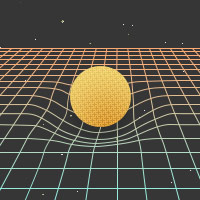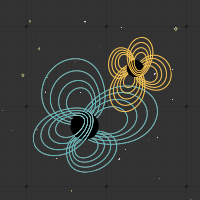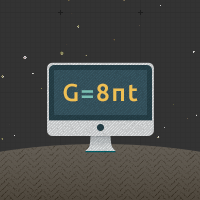Curving Space and Time
Warping Slices of Reality
Dark-heaving—boundless,
endless, and sublime,
The image of eternity—
the Throne of the Invisible...From Lord Byron's Childe Harold's Pilgrimage
Canto IV, Stanza 183
For his first revolution, Einstein unified space and time, and showed that a given observer just took a slice out of this spacetime. Each of the slices was flat: a one-dimensional slice was just a straight line; a two-dimensional slice was a flat sheet. In a similar way, the three-dimensional slices Einstein took were also flat, in a way we will explore below. For his second — and greater — revolution, Einstein allowed the slices to be curved and warped. One-dimensional straight lines became one-dimensional curvy lines; two-dimensional flat sheets became two-dimensional curvy sheets; three-dimensional flat spaces became three-dimensional curvy spaces. To understand this warping, it helps to think about warping in two-dimensional space.
We are all familiar with two-dimensional surfaces. Movie screens, pages in a book, and the surface of an apple are all examples. We also recognize a curved surface when we see it. Turn up half the page in a book, and you will see that it is curved. Leave the page down, and you see a flat surface. In high-school geometry class, we typically explore two-dimensional space, which is almost always assumed to be flat.
One familiar fact from this exploration is the formula for the circumference of a circle in terms of its radius. We remember the number π — pi, roughly 3.1416 — showing up in the formula
$$Circumference = 2 \times \pi \times Radius$$
To use this formula, we make a circle in a particular way. Choose any point, and tie one end of a length of rope to that point. Stretch the rope taut, and rotate around the center point, tracing out the position of the free end of the rope. This will leave us with a circle. If we measure around the circle — its circumference — we should find that it is 2 × π times the length of our rope.
Now imagine that you try to use this formula in a surface that is not flat. Choose the center point of the circle to be the top of a hill and pretend that you are trapped on the hill; you and your rope can't rise up off of it, or dig down inside of it. Draw the circle on the lower parts of the hill. If you now measure around the circumference of the circle you drew, you get a number that is less than 2 × π times the length of the rope! If we tried to make a circle centered on a mountain pass (or in the middle of a horse's saddle), we would get a circumference that is greater than 2 × π times the length of the rope. The classic formula doesn't apply in these curved space examples.
Now, to think about curvature in three dimensions, we recall another high-school formula that gives the surface area of a sphere in terms of its radius:
To use this formula, we make a sphere just as we made a circle, but we move everywhere the rope will let us. The places where the free end of the rope reach define a sphere. If we want to cover this sphere in fabric, for instance, we will need a piece 4 × π (about 12.566) times as big as a square with edges as long as our piece of rope, cut up into little patches, and sewn together just right. That piece of fabric should perfectly cover the sphere — assuming we have flat three-dimensional space.
In the bizarre world of curved three-dimensional space, however, we might need much less or much more fabric than we would think, just using the formula above. Again, the standard formula we learned in high-school (flat-space) geometry doesn't apply. It is not that this geometry is wrong, it's just that it only applies to flat space. We need a more sophisticated type of geometry to deal with curved space. That sophisticated geometry was developed by mathematicians, and called differential geometry.
With the second revolution, Einstein let his slices be warped in the ways we've just seen. Since he had brought space and time together in spacetime, this meant that time could be warped, too. Understanding warped space and time didn't come easy to Einstein, and he resisted as much as he could. Eventually, though, he came to realize that this warping was simply how nature worked, and the differential geometry describing it was the only way to deal with a fundamental concept in his theory: the geodesic.






